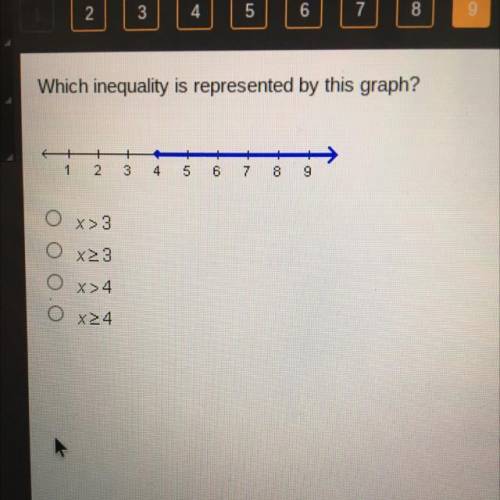Which inequality is represented by this graph?
+
1
2
3
4
5
ITD<...

Mathematics, 26.02.2021 17:30 masonprice
Which inequality is represented by this graph?
+
1
2
3
4
5
ITD
6
7
8
9
X>3
O XX3
O x>4
O x24


Answers: 1


Other questions on the subject: Mathematics

Mathematics, 21.06.2019 15:50, kendallreed39
3-12. write each answer with a reasonable number of figures. find the absolute uncertainty and percent relative uncertainty for each answer. (a) [12.41 (±0.09) + 4.16 (±0.01)] x 7.068 2 (±0.000 4) =? (b) [3.26 (±0.10) x 8.47 (±0.05)] - 0.18 (±0.06) =? (c) 6.843 (±0.008) x 104 + [2.09 (±0.04)- 1.63 (±0.01)] =?
Answers: 1


Mathematics, 21.06.2019 16:30, gerardoblk5931
Triangle inequality theorem state if each set of three numbers can be the lengths of the sides of a triangle. 1. 9, 8, 22. 2. 5,10,12. 3. 7,10,22. 4. 4,11,12. 5. 11,9,10. 6. 10,4,19. 7. 3,12,10. 8. 4,3,2. 9. 6,5,13. 10. 7,12,20. me .
Answers: 3

Mathematics, 21.06.2019 19:10, brownzackery71
Girardo is using the model below to solve the equation . girardo uses the following steps: step 1 add 4 negative x-tiles to both sides step 2 add 1 negative unit tile to both sides step 3 the solution is which step could be adjusted so that gerardo's final step results in a positive x-value? in step 1, he should have added 4 positive x-tiles to both sides. in step 1, he should have added 3 negative x-tiles to both sides. in step 2, he should have added 4 negative unit tiles to both sides. in step 2, he should have added 1 positive unit tile to both sides.
Answers: 2
You know the right answer?
Questions in other subjects:



Social Studies, 22.03.2021 18:00


Mathematics, 22.03.2021 18:00

History, 22.03.2021 18:00


Social Studies, 22.03.2021 18:00


Mathematics, 22.03.2021 18:00



